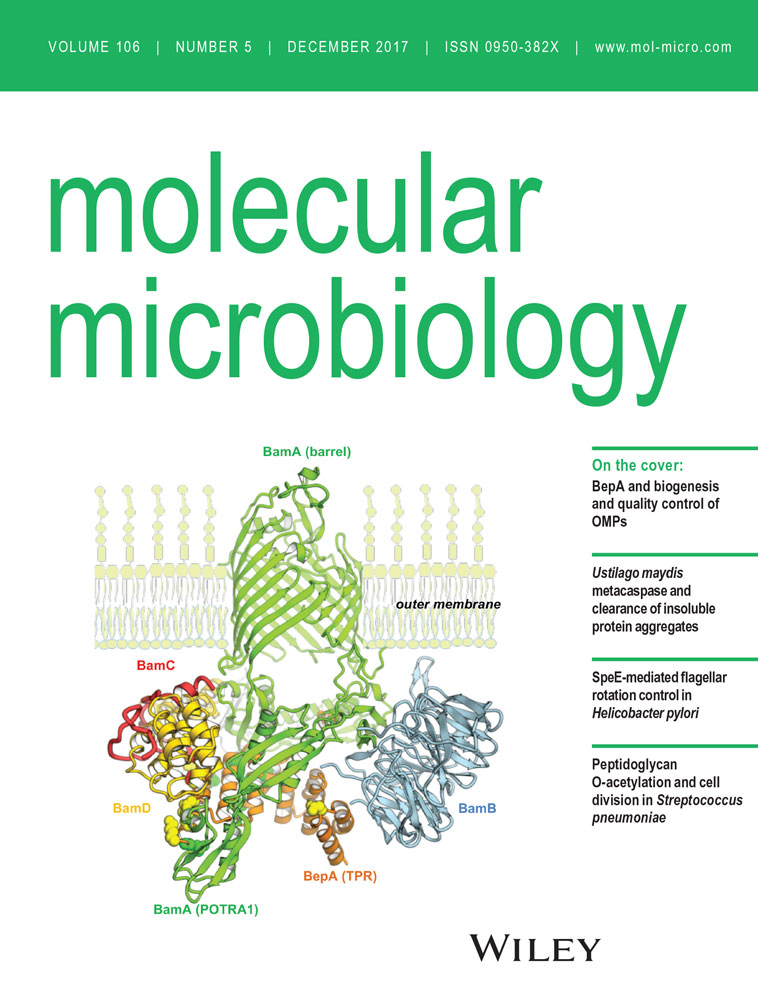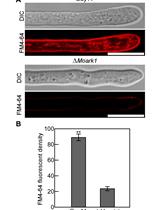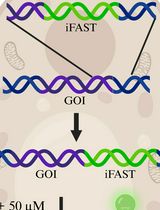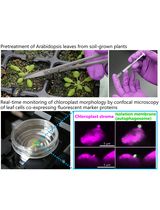- EN - English
- CN - 中文
Detection of Apoptosis-like Cell Death in Ustilago maydis by Annexin V-FITC Staining
膜联蛋白V-FITC染色检测玉米黑粉菌凋亡样细胞死亡
发布: 2018年08月05日第8卷第15期 DOI: 10.21769/BioProtoc.2948 浏览次数: 7585
评审: Anonymous reviewer(s)
Abstract
Programmed cell death (PCD) guides the transition between key developmental stages in many organisms. PCD also remains an important fate for many organisms upon exposure to different stress conditions. Therefore, an insight into the progression of PCD during the execution of a biological phenomenon can yield significant details of the underlying mechanism. Apoptosis, as well as apoptosis-like programmed cell death, constitutes one of the forms of PCD in higher and lower eukaryotes respectively. Flipping of phosphatidylserine (PS) from the inner leaflet of the plasma membrane to the outer leaflet is among the different hallmarks of apoptosis/apoptosis-like PCD that marks the initiation of the said cell death event. This flipping can be detected through staining of the target cells using annexin V-FITC that binds specifically to PS. In Ustilago maydis the staining of the externally exposed PS by annexin V-FITC is difficult due to the presence of cell wall. The key to such staining, therefore, relies on the gentle removal of the cell wall without significantly altering the underlying plasma membrane architecture/topology. This protocol highlights the dependence of the PS staining on the extent of protoplastation of the stressed cells in Ustilago maydis.
Keywords: Apoptosis (凋亡)Background
PS externalization constitutes one of the hallmarks of apoptosis-like PCD that can be detected very early (Martin et al., 1995). Hence the appearance of PS on the outer leaflet of the plasma membrane marks the onset of an apoptotic cell death phenomenon. Ustilago maydis is a biotrophic plant pathogen and infects host plant Zea mays. The lifecycle of U. maydis has been demonstrated to comprise of primarily two morphological forms namely the non-pathogenic haploid sporidial form and the pathogenic diploid filamentous form. The transition from the haploid to the diploid takes place through the mating of the compatible haploid strains on plant surfaces (Kahmann and Kamper, 2004). This leads to the generation of an infectious structure called appressoria that further penetrates the host plant as the filamentous form of the pathogen. Within the plant cells, the filamentous form of U. maydis again undergoes several transitions between morphologically distinct phases leading to sporulation. PCD has been demonstrated to play a significant role in the morphological transformations of different cell types primarily in higher eukaryotes (Buss et al., 2006; Suzanne and Steller, 2013). Also in some phytopathogenic fungi, PCD has been evidenced to be absolutely essential for the generation of appressoria (Veneault-Fourrey et al., 2006). Besides aiding in the switching between distinct morphological forms, PCD is also an end result of a harsh environmental stress response (Phillips et al., 2003). During penetration of the host plant the pathogens are exposed to a number of host defense response derived stress conditions. Among them, exposure to an increasingly oxidative environment is the most common. The primary reason behind this is the increased production of reactive oxygen species by the host in response to pathogen invasion (Torres et al., 2006). Assaying PCD in the fungal pathogen under each of these conditions mentioned can give significant insights into the pathogenic development as well as stress response of U. maydis. This protocol described the steps in detail to stain U. maydis sporidia under axenic culture conditions with annexinV-FITC to detect onset of any apoptosis-like cell death event upon exposure to adverse environmental conditions. However, it doesn’t include the staining of filamentous hyphae of U. maydis during its growth in-planta. Therefore this protocol is only applicable to the U. maydis sporidial cell suspension.
Materials and Reagents
- Plastic Petri-dishes (Tarsons, catalog number: 460020-90MM )
- 50 ml centrifuge tubes (Tarsons, catalog number: 546041 )
- 15 ml centrifuge tubes (Tarsons, catalog number: 546021 )
- 250 ml conical flasks (Fisher Scientific, FisherbrandTM, catalog number: 15429103 )
- Culture tubes (BOROSIL, catalog number: 9800U08 , 25 x 150 mm, 55 ml) with plastic caps (Tarsons, catalog number: 020070 )
- 10 ml disposable syringe (Dispo Van, Hindustan Syringes and Medical Devices Limited)
- 0.22 μm syringe filter (Sartorius, catalog number: 16532-K )
- Microscope slides (Polar Industrial, Blue Star, catalog number: PIC-1 , 75 x 25 mm)
- Cover slips (Blue Star, 22 mm square, 0.13-0.16 mm thick)
- Pipette tips (Tarsons, 0.2-10 μl, catalog number: 521000 ; 2-200 μl, catalog number: 521010 ; 200-1,000 μl, catalog number: 521020 )
- Inoculation loop
- Kimwipes (Tarsons, catalog number: 370080 , 11.17 x 21.3 cm)
- Sterile scalpel blades
- Organisms: Ustilago maydis solopathogenic strain SG200 (Kamper et al.,2006)
- Yeast extract powder (HiMedia Laboratories, catalog number: RM027 )
- Peptone, bacteriological (HiMedia Laboratories, catalog number: RM001 )
- Sucrose, A.R. (HiMedia Laboratories, catalog number: RM3063 )
- Potato Dextrose Broth (HiMedia Laboratories, catalog number: M403 )
- D-Sorbitol (Sigma-Aldrich, catalog number: S1876 )
- Tri-sodium citrate dihydrate (Merck, catalog number: 1.93619.0521 )
- Citric acid monohydrate (Merck, catalog number: 1.93011.0521 )
- Calcium chloride dihydrate (SRL Sisco Research Laboratories, catalog number: 0344317 )
- Tris (hydroxymethyl) aminomethane (Merck, Calbiochem, catalog number: 9210-OP )
- Hydrochloric acid about 37% (Merck, catalog number: 1.93001.0521 )
- Hydrogen peroxide 30% (Merck, catalog number: 1.93007.0521 )
- Lysing Enzymes from Trichoderma harzianum (Sigma-Aldrich, catalog number: L1412 )
- Annexin V-FITC apoptosis detection kit (Sigma-Aldrich, catalog number: APOAF )
- YEPSL media (see Recipes)
- Potato Dextrose Agar (PD agar) media (see Recipes)
- SCS buffer (see Recipes)
- Lysing enzymes in SCS (see Recipes)
- STC buffer (see Recipes)
- 10x binding buffer (see Recipes)
Equipment
- Pipette (0.5-10 μl, 2-20 μl, 20-200 μl, 100-1,000 μl)
- Weighing balance (Shimadzu, model: BL220H )
- Shaking incubator
- Double beam spectrophotometer (Hitachi High-Technologies, model: U-2910 )
- Light Microscope (ZEISS, model: Axioskop 40 )
- Confocal microscope (Leica Microsystems, model: Leica TCS-SP7 )
- Cold centrifuge (Thermo Fisher Scientific, Thermo ScientificTM, model: Sorvall RC 6 Plus , catalog number: 36-101-0816)
- Laminar air flow
- Autoclave
Procedure
文章信息
版权信息
© 2018 The Authors; exclusive licensee Bio-protocol LLC.
如何引用
Mukherjee, D., Mitra, A. and Ghosh, A. (2018). Detection of Apoptosis-like Cell Death in Ustilago maydis by Annexin V-FITC Staining. Bio-protocol 8(15): e2948. DOI: 10.21769/BioProtoc.2948.
分类
微生物学 > 微生物细胞生物学 > 细胞染色
细胞生物学 > 细胞成像 > 共聚焦显微镜
您对这篇实验方法有问题吗?
在此处发布您的问题,我们将邀请本文作者来回答。同时,我们会将您的问题发布到Bio-protocol Exchange,以便寻求社区成员的帮助。
Share
Bluesky
X
Copy link















